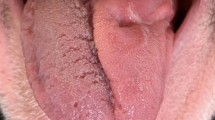Abstract
Objective
Hypoglossal nerve schwannomas are rare tumours that usually cause ipsilateral hypoglossal palsy. This report describes such lesions in two patients and suggests nerve grafting as part of the treatment regimen.
Method
Two patients with intra- and extra-dural hypoglossal schwannomas respectively were treated by direct surgery via a postero-lateral approach to the posterior fossa, hypoglossal canal and carotid sheath. Following tumour removal, sural nerve grafting was used to reconstruct the nerves. Unexpectedly, muscle bulk and motor function returned within 6 months in both patients.
Conclusion
Nerve grafting was highly successful in achieving functional recovery following surgery for hypoglossal nerve schwannomas.



Similar content being viewed by others
References
Bradley N, Bowerman JE (1989) Parapharyngeal neurilemmomas. Br J Oral Maxillofac Surg 27:139–146
George B, Lot G, Tran Ba Huy P (1995) The juxtacondylar approach to the jugular foramen. Surg Neurol 44:279–284
Gilsbach JM, Sure U, Mann W (1998) The supracondylar approach to the jugular tubercle and hypoglossal canal. Surg Neurol 50:563–570
Hoshi M, Yoshida K, Ogawa K, Kawase T (2000) Hypoglossal neurinoma-two case reports. Neurol Med Chir (Tokyo) 40:489–493
Keane JR (1996) Twelfth nerve palsy. Analysis of 100 cases. Arch Neurol 53:561–566
Leonetti JP, Wachter B, Marzo SJ, Petruzzelli G (2001) Extracranial lower cranial nerve sheath tumours. Otolaryngol Head Neck Surg 125:640–644
Mariniello G, Horvat A, Popovic M, Dolenc VV (2000) Cellular dumb-bell schwannoma of the hypoglossal nerve presenting without hypoglossal nerve palsy. Clin Neurol Neurosurg 102:40–43
McCurdy JA, Hays LL, Johnson GK (1976) Parapharyngeal neurilemmoma of the hypoglossal nerve. Laryngoscope 86:724–727
Morelli RJ (1966) Intracranial neurilemmoma of the hypoglossal nerve. Review and Case Report. Neurology 16:709–713
Myatt HM, Holland NJ, Cheesman AD (1998) A skull base extradural hypoglossal neurilemmoma resected via an extended postero-lateral approach. J Laryngol Otol 112:1052–1057
Omura S, Nakajima Y, Kobayashi S, Ono S, Fujita K (1997) Oral manifestations and differential diagnosis of isolated hypoglossal nerve palsy: report of two cases. Oral Surg Oral Med Oral Pathol Oral Radiol Endod 84:635–640
Pollock BE, Foote RL, Stafford SL (2002) Stereotactic radiosurgery: the preferred management for patients with non-vestibular schwannomas. Int J Radiat Oncol Biol Phys 15(52):1002–1007
Rachinger J, Fellner FA, Trenkler J (2003) Dumb-bell-shaped hypoglossal schwannoma. A case report. Magn Reson Imaging 21:155–158
Spinnato S, Talacchi A, Musumeci A, Turazzi S, Bricolo A (1998) Dumbbell-shaped hypoglossal neurinoma: surgical removal via dorso-lateral transcondylar approach. A case report and review of the literature. Acta Neurochir 140:827–832
Tamaguchi R, Fukushima T (2001) Seven cases of hypoglossal nerve schwannomas; case reports and analysis of the literature. 2nd Mt Bandaii Meeting Procedures,
Tuck RR, Mokri B, Cilluffo JM (1984) Intracranial schwannoma of the hypoglossal nerve. Arch Neurol 41:502–505
Tucker A, Miyake H, Tsuji M, Ukita T, Nishihara K, Ohmura T (2007) Intradural microsurgery and extradural gamma knife surgery for hypoglossal schwannoma: case report and review of the literature. Minim Invasive Neurosurg 50(6):374–378
Further Readings
Gomez BM, Fernandez CG, Garcia-Monco JC (2000) Hypoglossal schwannoma: an uncommon cause of twelth nerve palsy. Neurologia 15:182–183
Kachhara R, Nair S, Radhakrishnan VV (1999) Large dumb-bell neurinoma of hypoglossal nerve: case report. Br J Neurosurg 13:338–340
Author information
Authors and Affiliations
Corresponding author
Additional information
Comment
The CN XII neurinomas are a rather rare pathology among CN tumors. The fact that they might be of different size and location: intradural, intradural-intracanalicular, extracranial, and any combination offers even less possibility that larger series of these tumors could be assembled. In most cases, severe or complete ipsilateral atrophy of the tongue is already present when the diagnosis is established. In cases of large intradural CN XII neurinomas, the main aim is of course to remove the tumorous mass, while much less attention - if any - is paid to the possibility of reconstruction of CN XII. The anatomy of the hypoglossal canal of CN XII - though it has been studied and published - is not yet well understood and accepted [1]. In cases of only extracranial CN tumors, there is another problem, and that is that opinions differ as to which specialty should deal with it.
However the most important factor for such a tumor is also the fact that the anatomy of the region, when CN(s) IX, X, XI, and XII located immediately underneath the skull base, is also not an everyday practice. For all the above reasons, the present report is of great importance, since it represents a reasonable approach to CN XII tumors, not only in respect to removing them but also in respect to reconstructing CN XII. Of course, this approach does require a much wider and more complete type of treatment which is equally focused on excision of the tumor and on reconstruction of CN XII itself. The idea of vein sleeve and/or silastic shunt tubing is also very useful. The vein sleeve or other kind of tubing is not new, since it was implemented a long time ago in peripheral nerve reconstruction; however, it was forgotten and has not been used for a long time. With the help of fibrin glue and lumbar drainage following such a transdural surgery, also the CSF leak problem has been solved.
All in all, this report represents a very good piece of work and will for sure change the philosophy, not only for CN XII but also for the other CN tumors. The authors deserve to be congratulated.
Vinko V. Dolenc,
References:
1. Katsuta T, Matsushima T, Wen HT, Rhoton A Jr. Trajectory of the Hypoglossal Nerve in the Hypoglossal Canal: Significance for the Transcondylar Approach. Neurologia Medico-Chirurgica, Vol. 40, No. 4, April 2000; pp 206-210.
Rights and permissions
About this article
Cite this article
Mathiesen, T., Svensson, M., Lundgren, J. et al. Hypoglossal schwannoma—successful reinnervation and functional recovery of the tongue following tumour removal and nerve grafting. Acta Neurochir 151, 837–841 (2009). https://doi.org/10.1007/s00701-009-0226-4
Received:
Accepted:
Published:
Issue Date:
DOI: https://doi.org/10.1007/s00701-009-0226-4




